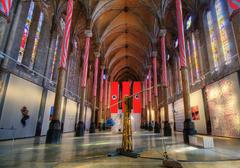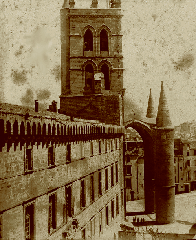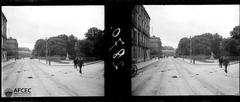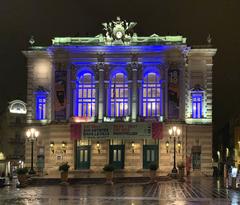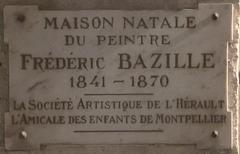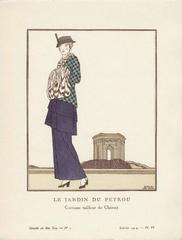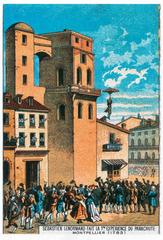Hôtel Pomier-Layrargues Montpellier: Comprehensive Visitor & Historical Guide
Date: 14/06/2025
Introduction
The Hôtel Pomier-Layrargues, located in the heart of Montpellier’s Écusson district, is a striking embodiment of 18th-century French architectural refinement and urban history. Built and remodeled by banker Jean Pomier in the 1740s, this elegant hôtel particulier features distinctive Louis XV façades, intricate Rocaille decorative motifs, and masterful wrought-iron work attributed to the city’s celebrated Bongues family. Although privately owned, its rare interior and architectural splendor can occasionally be experienced during special heritage events, making it a highlight for travelers interested in Montpellier’s cultural legacy (Wikipatrimoine; Montpellier Heritage).
This guide offers a detailed exploration of Hôtel Pomier-Layrargues: its origins, architectural features, heritage status, tips for visiting, and practical information for travelers.
Table of Contents
- Historical Overview
- Architectural Features
- Role in Montpellier’s Urban Heritage
- Cultural and Artistic Significance
- Visiting Information: Hours & Tickets
- Accommodation Options
- Guided Tours & Heritage Events
- Accessibility
- Nearby Attractions
- Visitor Tips
- Frequently Asked Questions
- Conclusion
- References
Historical Overview
Origins and Construction
The Hôtel Pomier-Layrargues was established in 1742 by Jean Pomier, a prominent local banker. Rather than building anew, Pomier acquired two adjacent medieval houses, preserving their structural walls but transforming their façades and interiors to reflect Enlightenment ideals and the Rococo style. This approach was emblematic of Montpellier’s evolving urban landscape, where the medieval city core was gradually overlaid with classical and baroque influences as the mercantile elite rose in prominence (Wikipatrimoine; Montpellier Heritage).
Historical Context
The hôtel particulier typology—private urban mansions for the elite—flourished in Montpellier during the 17th and 18th centuries. Hôtel Pomier-Layrargues is among nearly 70 such residences that helped define the character of the Écusson district, reflecting the social hierarchy and artistic ambitions of their owners.
Architectural Features
Exterior Elements
- Façade: Uniformly reworked windows with arched tops and Louis XV-style keystones set in pale local limestone.
- Portal: A grand “anse de panier” (basket-handle) arch entrance, deeply recessed and articulated with rusticated masonry and crossetted stonework.
- Ornamentation: Rocaille shell motifs and elaborate keystones, contributing to the building’s elegant street presence.
- Ironwork: Wrought-iron balustrades and gates crafted by the Bongues family, exemplifying Montpellier’s artisanal tradition.
Interior Highlights
- Oval Vestibule: A rare architectural element, adding spatial sophistication.
- Grand Staircase: Features three flights and Rocaille consoles, including sculpted heads of Hercules and mythological figures.
- Courtyard: The internal courtyard, or cour d’honneur, admits light and air, acting as the building’s social and architectural heart.
These features collectively illustrate the transition from medieval to Enlightenment design, blending older structures with the luxurious decorative vocabulary of the Rococo period (Wikipatrimoine; POP Culture).
Role in Montpellier’s Urban Heritage
The Hôtel Pomier-Layrargues anchors the Écusson district, Montpellier’s historic core, known for its maze of medieval streets, classical mansions, and vibrant public spaces. Its preservation as a Monument Historique underscores the city’s commitment to safeguarding its architectural heritage and provides a tangible link to the social customs of the Ancien Régime (Monumentum).
Cultural and Artistic Significance
- Artisan Legacy: The building’s ornate ironwork connects it to Montpellier’s renowned Bongues family of ironmongers, whose craftsmanship defines much of the city’s historic fabric.
- Rococo Influence: The adoption of Louis XV and Rocaille motifs reflects the city’s alignment with national artistic trends and the cosmopolitan tastes of its elite.
- Monument Historique: Protected since 1992, ensuring its façades, roofs, and grand staircase are preserved for future generations (POP Culture).
Visiting Information: Hours & Tickets
Can You Visit the Hôtel Pomier-Layrargues?
- Regular Access: The hôtel is a private residence and does not offer standard visiting hours or ticketed entry.
- Special Events: Interior access is possible during the European Heritage Days (Journées Européennes du Patrimoine) in September, when guided tours may be available. Entry is usually free during these events, but advance reservations are often required (Montpellier Tourist Office).
- Exterior Viewing: The Louis XV façade and architectural details can be viewed and photographed from rue de l’Argenterie at any time.
Accommodation Options
A portion of the building is available as a short-term rental apartment, “Design & Cosy – Centre historique Ecusson,” which offers:
- 1 bedroom, 1 bathroom, and a fully equipped kitchen (approx. 35 m²)
- Free Wi-Fi and modern amenities
- High guest ratings for cleanliness, comfort, and location
- Access via stairs (not suitable for those needing step-free entry)
Booking is available through Booking.com. Early reservation is recommended, especially during peak seasons.
Guided Tours & Heritage Events
- Walking Tours: The Montpellier Tourist Office offers guided walking tours that showcase the city’s hôtels particuliers, often stopping at Hôtel Pomier-Layrargues to discuss its history and architectural features (CN Traveller).
- European Heritage Days: The only regular opportunity to enter the interior, including the grand staircase and vestibule. Check official event programs for schedules (Monumentum).
Accessibility
- The hôtel’s medieval location and historic layout mean accessibility is limited, especially for those with reduced mobility.
- The rental apartment is on an upper floor and accessed by stairs.
- Cobblestone streets and narrow pathways in the Écusson district may present challenges (Booking.com).
Nearby Attractions
Within a short walk of Hôtel Pomier-Layrargues:
- Place de la Comédie: Montpellier’s lively central square
- Musée Fabre: Major European art museum
- Montpellier Cathedral (Saint-Pierre)
- Other hôtels particuliers: Hôtel de Gayon, Hôtel d’Hostalier, Hôtel de Bénézet (Gralon)
- Cafés, markets, and boutiques fill the surrounding streets
Visitor Tips
- Best Time to Visit: Spring and early autumn for pleasant weather
- Language: French is primary; English widely spoken in tourist areas
- Transportation: Multiple tram lines and bus routes serve the Écusson. Public parking is limited but available nearby (CN Traveller)
- Photography: Unrestricted for the exterior; interior photography may be limited during special events
- Booking: Reserve accommodation and event tickets early, especially during festivals
Frequently Asked Questions
Can I visit the interior of Hôtel Pomier-Layrargues?
Regular interior access is unavailable, except during the European Heritage Days.
Are there tickets required to visit?
No ticket is needed to view the exterior. Special event tickets may be required for guided tours during heritage events.
Is the apartment rental accessible for those with reduced mobility?
No, the apartment is accessed by stairs and may not be suitable for those requiring step-free access.
Where can I park nearby?
Public parking is available in the historic center, but spaces are limited.
Are there other hôtels particuliers I can visit in Montpellier?
Yes, several other private mansions are featured on city walking tours and in heritage event programs.
Conclusion
The Hôtel Pomier-Layrargues is a standout among Montpellier’s historical sites, offering a rare intersection of architectural elegance, urban history, and cultural legacy. While regular interior visits are limited due to private ownership, the annual European Heritage Days provide a unique opportunity to experience its opulent interiors. Whether admiring its façade, joining a walking tour, or staying in its boutique apartment, visitors are treated to a memorable showcase of Montpellier’s layered past.
For up-to-date visitor information, booking links, and heritage event schedules, consult official city and tourism resources before your trip.
References
- Wikipatrimoine: Hôtel Pomier-Layrargues
- Montpellier Heritage: A Thousand Years of History
- Montpellier Tourist Office: Traveller Information
- Monumentum: Hôtel Pomier-Layrargues Monument Historique
- POP Culture: Mérimée Database Entry
- Booking.com: Design & Cosy – Centre historique Ecusson Apartment
- Gralon: Hôtel Pomier-Layrargues Monument Info
- CN Traveller: Montpellier Travel Guide
